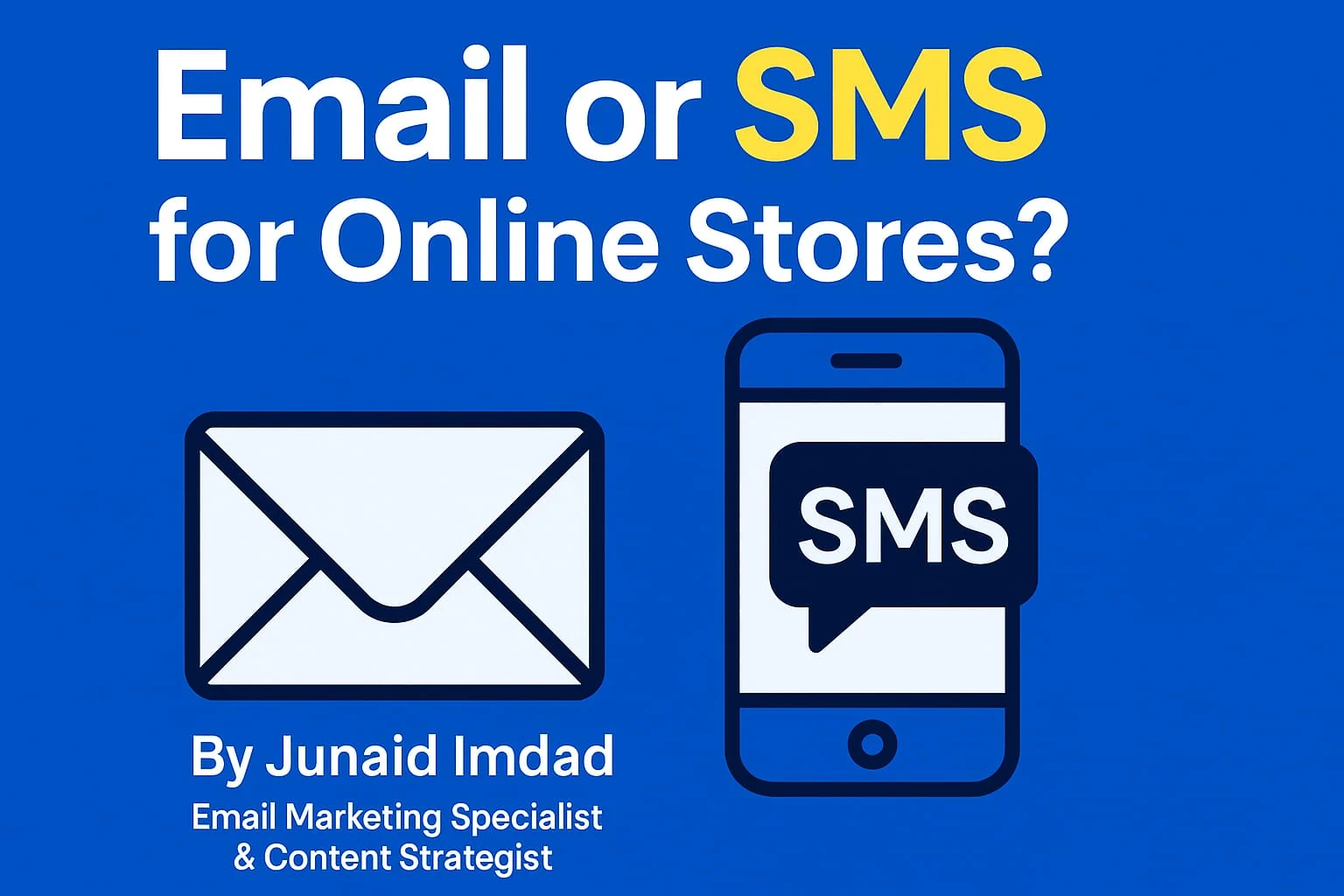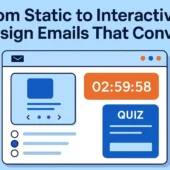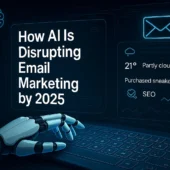By Junaid Imdad, Blogger & Digital Experience Strategist
In the fast-moving realm of eCommerce, where every click, swipe, and notification can tip the scales between a sale and a lost chance, marketers often grapple with a crucial question: Which marketing channel brings in better results—email or SMS? In this post, we’ll dive deep into the Email vs SMS Marketing debate, breaking down the strengths, weaknesses, and best-use scenarios for each channel.
The answer isn’t always clear-cut.
As a digital content strategist with over five years of hands-on experience in online marketing, I’ve witnessed how both email and SMS marketing have transformed—shaped by advancements in technology, shifts in consumer behavior, and changes in algorithms. While email marketing has long been a staple of digital communication, SMS has quickly gained traction in recent years, fueled by the growing need for speed, personalization, and immediacy.
Email marketing shines in scalability, depth, and cost-effectiveness. It’s perfect for sharing long-form content, nurturing customer relationships, providing product updates, offering discounts, and sending automated sequences that guide users through their buying journey. Plus, with the rise of AI, marketers can now personalize campaigns on a larger scale—tweaking tone, frequency, and content based on real-time data. When executed well, email can achieve impressive open rates, click-through rates, and conversion rates, all while keeping your brand fresh in the customer’s mind.
Conversely, SMS marketing thrives on urgency, simplicity, and directness. In a time when attention spans are dwindling, SMS cuts through the clutter by landing straight in the user’s inbox—often resulting in open rates as high as 98%. From flash sales and order confirmations to abandoned cart reminders and back-in-stock notifications, SMS facilitates real-time, one-on-one interactions with your customers that prompt immediate action.
But here’s the kicker: it’s not always about choosing one over the other. In fact, some of the most successful eCommerce brands today are discovering that blending both channels—harnessing the depth of email alongside the immediacy of SMS—creates a more connected, responsive, and profitable customer experience.
Understanding the Basics
What Is Email Marketing?
Email marketing is all about sending well-thought-out, targeted messages through email to a specific group of subscribers who have chosen to hear from your brand. These messages can cover a variety of purposes—from promotional deals and product launches to newsletters, event invites, seasonal campaigns, loyalty programs, follow-ups after purchases, and reminders for abandoned carts.
For more than twenty years, email marketing has been a key player in digital marketing, consistently showing itself to be one of the most effective and budget-friendly ways to build and maintain long-lasting relationships with customers. Especially in the eCommerce world, email helps brands keep in touch with their audience at every step of the customer journey—from the initial discovery and consideration stages to making a purchase and encouraging repeat business.
What really makes email stand out is its incredible ability to deliver content, its design flexibility, and the power of data-driven personalization. Modern email marketing tools like Klaviyo, Mailchimp, ActiveCampaign, and HubSpot come packed with automation features that let businesses create complex workflows based on user behavior. These platforms can break down audiences into segments based on things like browsing habits, previous purchases, demographics, or how engaged they are, allowing for highly personalized messaging on a large scale.
Additionally, email marketing is perfect for storytelling, sharing educational content, and building your brand—thanks to its capacity for long-form content, rich media, and embedded calls-to-action. You can highlight a new product line with eye-catching images, provide a detailed comparison guide, or educate your audience through a multi-part welcome series that fosters trust over time.
In the ongoing discussion about Email versus SMS Marketing for eCommerce, email stands out with its unique strengths: it’s a well-established, flexible, and customizable channel. It’s perfect for sharing detailed content, supporting omnichannel marketing efforts, and ensuring a steady return on investment. Recent industry research shows that email marketing continues to provide one of the best returns, averaging between $36 to $42 for every dollar spent—especially when paired with timely SMS support.
While SMS offers quick and concise communication, email excels in situations where depth, detail, and personalization matter most. It enables brands to build long-term loyalty, gather valuable insights, and enhance customer lifetime value through meaningful engagement.
Typical Applications:
(Weekly newsletters, product promotions and drip campaigns).
Cart abandonment reminders will also be sent.
What is SMS?
SMS (short message service) marketing involves sending text messages directly to consumers’ mobile phones, typically achieving open rates that exceed 90%. It’s one of the fastest and most effective ways to engage customers, especially for time-sensitive promotions or urgent updates. In the Email vs SMS Marketing for eCommerce debate, SMS stands out for its immediacy and high engagement, making it ideal for flash sales, limited-time offers, and real-time alerts.
Use Case Examples:
(flash sales or limited time offers).
- Order and shipping notifications available
- Customized discount codes
- Event reminders or new product alerts
Let’s face it, email inboxes can be an unforgiving place. Between spam filters and overcrowded promotions tabs, even the best-crafted messages risk getting lost. According to data from Campaign Monitor, eCommerce brands typically see an average email open rate between 20–25%. In the context of Email vs SMS Marketing for eCommerce, this highlights one of email’s key challenges: visibility. While email excels in depth and design, its effectiveness often hinges on subject lines, timing, and deliverability.
SMS marketing boasts open rates of over 90%, often within minutes after delivery!
Real Talk: SMS will generally outperform email for promoting time-sensitive campaigns such as flash sales. Their immediacy makes text messages perfect for such efforts.
Email vs SMS Marketing for eCommerce
In the fast-paced world of eCommerce today, where capturing customer attention is a challenge and expectations are sky-high, brands really need to think strategically about how they connect with their audience. A key decision that modern marketers often grapple with is choosing between Email and SMS Marketing for eCommerce—each channel comes with its own strengths, weaknesses, and unique benefits.
Email marketing has been a go-to tool for digital marketers for quite some time, celebrated for its ability to create rich, engaging experiences. With email, you can showcase eye-catching visuals, tailor product recommendations, include dynamic calls to action, and weave in long-form storytelling—all in one message. This makes it perfect for product launches, newsletters, educational content, and reminders for abandoned carts. Plus, email offers powerful segmentation and automation features, enabling brands to craft detailed campaigns based on user behavior, purchase history, and engagement levels.
On the other hand, SMS marketing is all about speed, simplicity, and urgency. With open rates often soaring above 90% and most messages being read within minutes, SMS is ideal for flash sales, time-sensitive promotions, order confirmations, and shipping updates. Although the character limit means you have to keep messages short, that brevity can actually work to your advantage—helping you cut through the clutter and deliver timely value directly to the user’s mobile device.
Conversion Rates Aren’t Always an Easy Call
In the Email vs SMS Marketing for eCommerce discussion, open rates only tell half the story. What truly matters is conversion—how many customers actually make a purchase after engaging with your message. While email offers more space for storytelling and visuals, SMS often drives quicker actions, making it crucial to evaluate not just engagement, but actual results.
Omnisend’s 2024 report suggests:
Email campaigns typically experience a 6% conversion rate.
SMS campaigns typically reach 8-12% success depending on offer and timing considerations.
In the Email vs SMS Marketing for eCommerce landscape, performance metrics can vary significantly depending on context. For instance, SMS often performs better for time-sensitive campaigns like weekend-only sales due to its immediacy, while email excels when more detailed content is needed such as product descriptions, visuals, and layered promotional messaging.
Personalization and Content: Email Offers Greater Versatility
When it comes to storytelling and delivering rich, informative content, email remains unmatched in its versatility. In the Email vs SMS Marketing for eCommerce comparison, email is ideal for sharing compelling narratives, showcasing multiple images, and including educational material. You can leverage rich media, segment your audience lists, A/B test subject lines, and even customize entire customer journeys all of which contribute to deeper engagement and higher conversion potential.
In the Email vs SMS Marketing for eCommerce debate, SMS stands out for its brevity—allowing up to 160 characters per message (unless using MMS). This forces marketers to be concise and direct, which can be incredibly effective for time-sensitive updates or clear calls to action. However, the limited space also presents challenges; too few words can result in vague messaging or overly promotional content that lacks context or personalization. Striking the right balance is key to making SMS a high-impact tool in your marketing strategy.
Example
Email : (to be sent) “Introducing our brand-new vegan skincare range! Click to explore ingredients, customer reviews and take advantage of a 15% discount!”
SMS: “Vanilla skincare is now available! Take advantage of it now to take advantage of a 15% discount: [link].”
Customer Preferences: Dependent on Relationship
In the context of Email vs SMS Marketing for eCommerce, it’s clear that modern customers expect brands to communicate in ways that align with their lifestyles. Some consumers prefer long-form emails they can read at their leisure—perhaps during a lunch break—while others gravitate toward short, snappy SMS messages that deliver the essentials instantly. Understanding and catering to these preferences is key to building stronger connections and driving more meaningful engagement.
Recent surveys demonstrate:
- 65% of consumers prefer receiving promotions via email.
- 30-40% of SMS users prefer using it for order updates and urgent deals.
Therefore, rather than picking one over the other, a more strategic solution would likely involve using both approaches simultaneously.

Email Is More Cost-Effective Than SMS
When evaluating Email vs SMS Marketing for eCommerce, cost is a major factor to consider. Email marketing typically proves to be more cost-effective, with many platforms offering flat monthly fees based on subscriber count. In contrast, SMS marketing often incurs charges per message sent, which can quickly add up—especially for larger campaigns. For brands with tight budgets or extensive mailing lists, email often offers a more scalable and affordable solution.
Here’s an approximate breakdown:
Emails cost between $0.001-$0.02 per message sent.
In the Email vs SMS Marketing for eCommerce comparison, cost per message is an important consideration. SMS text messaging typically ranges from $0.05 to $0.15 per message, depending on factors like volume and region. As message volume increases, so does the overall cost—making SMS a potentially expensive channel for large-scale campaigns.
In the Email vs SMS Marketing for eCommerce conversation, if you’re working with a limited budget, email may be the ideal long-term channel for cultivating leads and building lasting customer relationships. Its low cost per message and powerful automation capabilities make it a sustainable and scalable option for growing your brand over time.
Compliance and Privacy: Both Require Care
In the ongoing discussion about Email versus SMS Marketing for eCommerce, there’s one crucial aspect that often gets overlooked: regulatory compliance. No matter how engaging your content is or how precise your targeting may be, ignoring digital communication laws can lead to serious legal troubles, hefty fines, and lasting harm to your brand’s reputation.
Email marketing is subject to the CAN-SPAM Act in the United States, which lays out several key requirements for marketers. These include clearly identifying the sender in the “From” and “Reply-To” fields, providing a physical mailing address, steering clear of misleading subject lines, and giving recipients a straightforward way to opt out of future emails. If you don’t comply, you could face penalties of up to $50,000 for each violation—so it’s essential to weave compliance into your email automation and content processes.
On the flip side, SMS marketing is bound by even stricter regulations under the Telephone Consumer Protection Act (TCPA). This law mandates that you obtain express written consent before sending out marketing text messages, and it’s up to the business to prove that consent was given. Each message must also identify the sender and include instructions on how to stop receiving future texts—usually as simple as “Reply STOP to unsubscribe.” Ignoring TCPA rules can lead to fines ranging from $500 to $1,500 for each message sent to each recipient.
SMS violations tend to carry more severe repercussions due to their more personal nature and stringent regulations.
Whatever route you take, ensure your data collection and marketing practices follow all regulations.

Email Vs SMS
Both email and SMS marketing have their strengths, and the key to success lies in knowing when to use each channel effectively. Here’s a breakdown to guide your strategy:
| Situation | Best Channel |
|---|---|
| Flash Sale | SMS |
| Product Launch | |
| Cart Abandonment | |
| Shipping Confirmation | SMS |
| Weekly Newsletter Delivery |
Benefits of Email Marketing
In the Email vs SMS Marketing for eCommerce debate, email stands out as a cost-effective and scalable channel, especially when compared to the higher per-message fees associated with SMS marketing. Here are five key benefits of email marketing:
- Low Per-Message Costs: Email platforms typically charge flat monthly fees based on subscriber count, making it affordable to scale without increasing per-user messaging costs.
- High Scalability: You can send thousands of messages simultaneously at little additional cost, ideal for growing eCommerce audiences.
- Richer Content Format: Emails support images, long-form content, product carousels, and personalized recommendations—making them perfect for storytelling and promotions.
- Automation & Segmentation: Advanced tools allow for behavior-based automation and list segmentation, improving targeting and boosting conversions.
- Better for Re-Engagement: Email is ideal for nurturing inactive subscribers, abandoned carts, and post-purchase follow-ups through thoughtful and data-driven campaigns.
While SMS excels in immediacy and urgency, email remains the preferred choice for more detailed, cost-efficient, and creative campaigns that nurture long-term customer relationships.
Final Thoughts:
When it comes to Email vs SMS Marketing for eCommerce, it’s not about choosing one over the other. As an online store owner or eCommerce marketer, you shouldn’t view email and SMS as competing channels, but rather as complementary tools. Smart brands are leveraging both in tandem—using SMS for real-time urgency and email for in-depth storytelling and personalization—to build a cohesive, high-performing marketing strategy that reaches customers at every stage of the journey.
Email excels at storytelling, education, and brand building; while SMS delivers instantaneous, urgent reminders. If you want to get info about Ai disrupting email, simply click on it.

Here is how an actual brand might structure their funnel:
- Email 1: Product announcement with story, details and value props.
- Email 2: 24 hours later, I sent another reminder and testimonials.
- SMS: Final two-hour countdown with an exclusive discount offer.
Ultimately, it doesn’t have to be about choosing either email or SMS; the key question should be how I can use both channels effectively in ways that feel natural and beneficial to my customer base?
Are you having difficulty setting up email and SMS funnels? I can help. I have assisted numerous eCommerce brands increase conversions using ethical, user-first marketing. Let’s connect today so we can discuss.




How AI Is Disrupting Email Marketing by 2025 - Devitcity
[…] No; however it will replace those who fail to adapt quickly enough. If you want to know about email versus SMS, simply click on […]
Google's 2025 Helpful Content Update: What You Should Change Right Away - Devitcity
[…] users solve problems, make decisions or learn something new. If you also want to get info about email versus SMS, simply click on […]
Gamification in SEO: Why Google Favours Interactive Content in 2025 - Devitcity
[…] experiences that users–and search engines–cannot resist. If you also get info about email versus SMS, simply click on […]
From Static to Interactive: Design Emails That Convert - Devitcity
[…] work and how you can start designing them to increase conversions. If you want to get info about email versus SMS, simply click on […]
Generative Engine Optimization (GEO) and Why it Is the Future of SEO in 2025 - Devitcity
[…] you want to get info about email versus SMS, simply click on […]